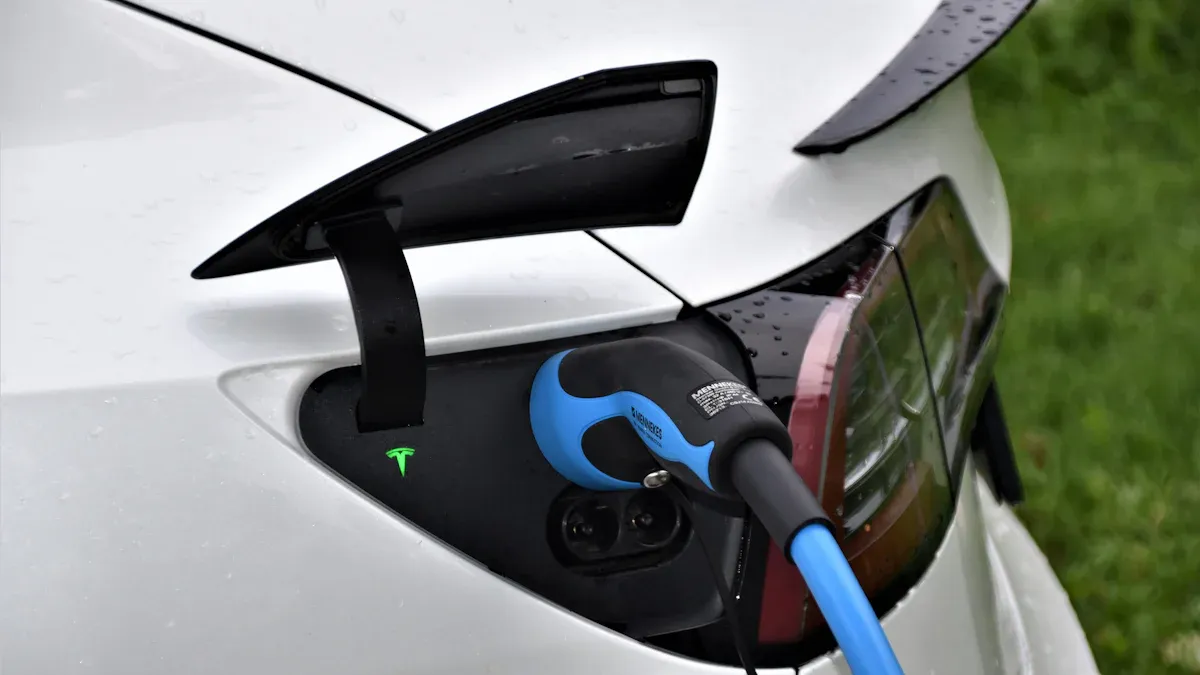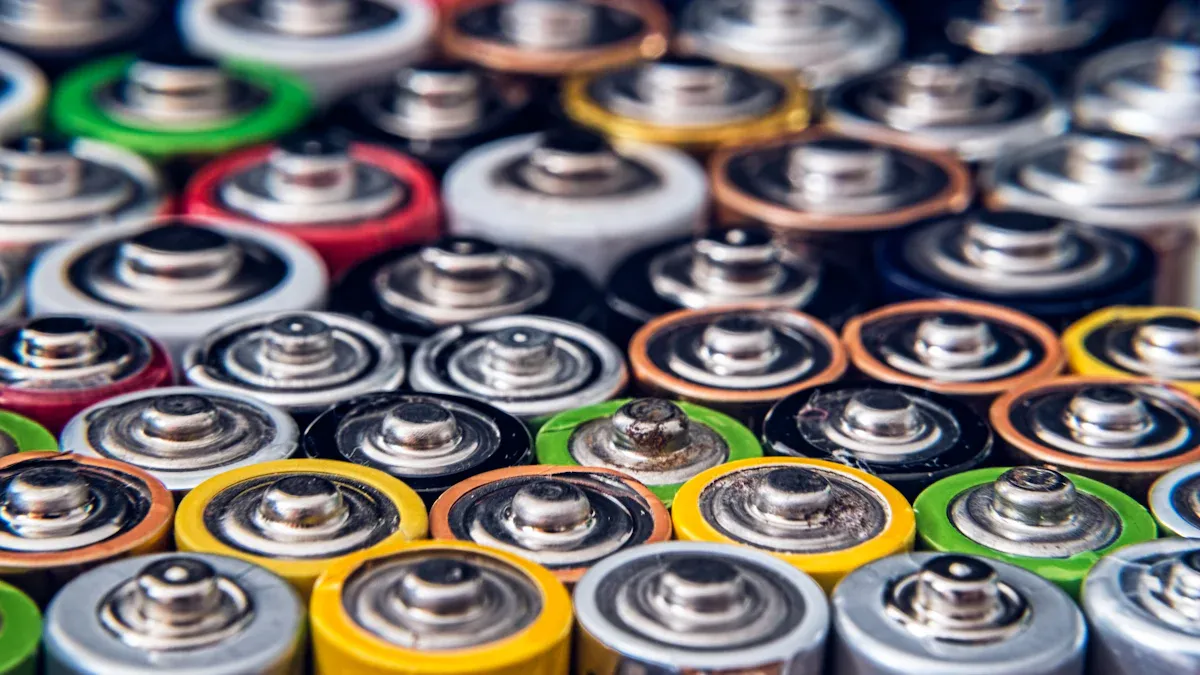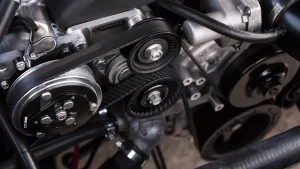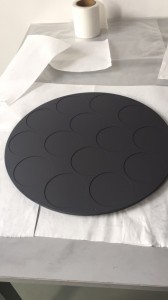
Revêtement TaC significantly enhances the performance of high-temperature EV battery components. Its exceptional thermal resistance and chemical stability protect critical parts from degradation caused by extreme heat. This innovation reduces wear, enhances reliability, and ensures long-lasting functionality. As the Marché des revêtements du TAC continues to expand, technologies such as revêtement cvd sic further complement these advancements, propelling the future of energy storage through TAC Technologie de revêtement.
Traits clés
- TaC Coating makes EV battery parts last longer by resisting heat and chemicals.
- It helps battery parts work longer, lowers repair costs, and supports eco-friendly practices in the EV field.
- TaC Coating works better than old coatings by protecting against heat and staying strong, perfect for hot conditions.
Challenges in High-Temperature EV Battery Components
Thermal Degradation and Its Effects
High temperatures pose a significant challenge to EV battery components. Prolonged exposure to heat accelerates thermal degradation, reducing the efficiency and capacity of lithium-ion batteries. Studies reveal that cooling methods play a critical role in mitigating this issue. For instance, batteries using thermal control (TC) systems experience nearly 50% more capacity loss over 500 cycles compared to those with standard cooling (SC).
Thermal degradation also impacts the electrolyte and electrodes within the battery. Elevated temperatures increase the aging rate of these components, leading to a decline in maximum charge storage capacity. This degradation compromises the battery’s overall performance and reliability, making it essential to adopt advanced protective measures like TaC Coating.
Wear and Corrosion in Extreme Conditions
Extreme environmental conditions, such as high humidity and salt exposure, accelerate wear and corrosion in EV battery components. Humidity testing has shown that moisture can degrade battery materials, while salt fog testing highlights the corrosive effects of saltwater. Coastal environments, in particular, exacerbate these issues, as salt-laden air promotes rapid corrosion.
Severe weather events further amplify these risks. During Hurricane Ian in 2022, submerged EV batteries caught fire due to water ingress and subsequent damage. Such incidents underscore the importance of robust protective solutions to enhance battery durability under extreme conditions.
Reduced Component Lifespan
High temperatures and environmental stressors significantly reduce the lifespan of EV battery components. Research indicates that temperature fluctuations accelerate the aging process of electrodes and electrolytes, leading to a shorter operational life. A comprehensive study on temperature effects revealed that higher operating temperatures directly correlate with faster aging rates across all battery sections.
By addressing these challenges, innovations like TaC Coating provide a transformative solution. Its exceptional thermal resistance and chemical stability protect critical components, ensuring long-term reliability and performance in demanding conditions.
Comprendre le revêtement TaC

Composition and Properties of Tantalum Carbide
Tantalum carbide (TaC) is a ceramic material known for its exceptional hardness and thermal properties. Studies have measured its anomalous hardness through indentation experiments, using advanced tools like the Agilent Nano Indenter G200. The synthesis of TaC involves techniques such as hot isostatic pressing and reactive sputter deposition, ensuring high material density and uniformity.
Quantitative data highlights its melting point, which surpasses many other refractory materials, including tungsten. These properties make TaC a preferred choice for applications requiring durability under extreme conditions.
High Melting Point and Chemical Stability
TaC exhibits one of the highest melting points among known materials, measured at an impressive 4041 K. Laboratory experiments confirm its chemical stability, as only cubic TaC grains were observed in melted samples. No lower-temperature thermal arrests were detected, further validating its resistance to chemical degradation.
"The experimental findings indicate that the melting temperature of TaC was measured at 4041 K, which is lower than that of HfC. Additionally, the analysis confirmed that only cubic TaC grains were present in the melted samples, with no lower temperature thermal arrests observed, suggesting chemical stability."
This combination of a high melting point and chemical stability ensures that TaC remains effective in high-temperature environments, making it indispensable for demanding applications like EV battery components.
Why TaC Coating is Ideal for EV Batteries
TaC Coating offers unparalleled benefits for EV battery components. Its oxidation resistance enhances the durability of carbon-based materials, while its mechanical stability ensures performance under extreme heat. Additionally, advanced preparation methods result in coatings with low ablation rates, making them suitable for high heat flux conditions.
| Research Findings | Désignation des marchandises |
|---|---|
| Oxidation Resistance | TaC coatings significantly enhance the oxidation resistance of carbon-based materials. |
| Stabilité mécanique | TaC exhibits excellent high-temperature mechanical stability. |
| Ablation Resistance | Coatings prepared using advanced methods show low mass and linear ablation rates. |
These attributes make TaC Coating a transformative solution for protecting EV battery components from thermal degradation, wear, and corrosion. Its ability to withstand extreme conditions ensures long-term reliability and efficiency.
Benefits of TaC Coating for Durability
Thermal Resistance for Extreme Heat Protection
TaC Coating provides exceptional thermal resistance, making it ideal for high-temperature environments. Its ability to withstand extreme heat ensures that EV battery components remain stable and functional even under intense operating conditions. Laboratory tests have demonstrated that materials coated with TaC maintain their structural integrity at temperatures exceeding 3000°C. This resistance minimizes the risk of thermal degradation, which often leads to reduced battery efficiency and capacity. By acting as a thermal barrier, TaC Coating protects critical components, ensuring consistent performance and reliability.
Wear and Corrosion Resistance
In addition to thermal protection, TaC Coating offers superior resistance to wear and corrosion. Its dense, hard surface prevents mechanical abrasion, which is common in high-stress environments. Furthermore, the coating’s chemical stability shields components from corrosive agents such as moisture, salt, and other environmental contaminants. Studies have shown that TaC-coated materials exhibit significantly lower wear rates compared to uncoated counterparts. This durability ensures that EV battery components can endure harsh conditions without compromising their functionality.
Extending Component Lifespan
The combined benefits of thermal resistance, wear protection, and corrosion resistance contribute to a longer lifespan for EV battery components. TaC Coating reduces the rate of material degradation, allowing components to perform efficiently over extended periods. This longevity not only enhances the reliability of electric vehicles but also reduces maintenance costs and the need for frequent replacements. By extending the operational life of critical parts, TaC Coating supports the sustainability goals of the EV industry.
Applications of TaC Coating in EV Batteries

Protecting Connectors
Connectors in EV batteries play a critical role in ensuring efficient energy transfer between components. However, these connectors often face challenges such as thermal stress and corrosion, especially in high-temperature environments. TaC Coating provides a robust solution by forming a protective barrier that resists heat and chemical reactions. This coating minimizes the risk of connector failure, ensuring uninterrupted energy flow and reducing the likelihood of costly repairs. By enhancing the durability of connectors, TaC Coating contributes to the overall reliability of electric vehicles.
Enhancing Thermal Management Systems
Thermal management systems are essential for maintaining optimal battery performance. These systems regulate heat generated during charging and discharging cycles. TaC Coating improves the efficiency of these systems by providing superior thermal resistance and stability. A 2024 study by the European Wind Energy Association highlighted a 17% reduction in maintenance costs for turbine blades using TaC-coated tooling. This finding underscores the operational efficiency gains achievable with TaC Coating, even in demanding environments. By applying this technology to EV battery thermal management systems, manufacturers can achieve better heat regulation and lower maintenance costs.
Improving Battery Casings
Battery casings protect internal components from external damage and environmental factors. High temperatures, moisture, and corrosive agents can compromise the integrity of these casings over time. TaC Coating enhances the durability of battery casings by offering exceptional resistance to wear and corrosion. Its high melting point ensures that casings remain structurally sound even under extreme conditions. This added layer of protection extends the lifespan of the battery, reducing the need for frequent replacements and supporting the sustainability goals of the EV industry.
Why TaC Coating Outperforms Alternatives
Comparison with Ceramic and Metal Alloy Coatings
Ceramic and metal alloy coatings have long been used to protect components in high-temperature environments. However, these materials often fall short in extreme conditions. Ceramic coatings provide good thermal insulation but lack the mechanical strength to resist wear and impact. Metal alloy coatings offer durability but struggle with oxidation and corrosion at elevated temperatures.
TaC Coating surpasses these alternatives by combining the best of both worlds. Its ceramic-like thermal resistance shields components from intense heat, while its exceptional hardness prevents mechanical damage. Unlike metal alloys, TaC Coating resists chemical reactions, ensuring long-term stability. This unique combination of properties makes it the superior choice for demanding applications like EV battery components.
Superior Performance in High-Temperature Environments
High-temperature environments challenge most protective coatings, leading to material degradation and reduced efficiency. TaC Coating excels under these conditions due to its high melting point and chemical stability. Laboratory tests confirm its ability to maintain structural integrity at temperatures exceeding 3000°C, outperforming both ceramic and metal alloy coatings.
Remarque: TaC Coating’s resistance to thermal stress ensures consistent performance, even during prolonged exposure to extreme heat. This reliability makes it indispensable for EV batteries operating in high-temperature scenarios.
Long-Term Cost-Effectiveness
While initial investment in TaC Coating may seem higher, its long-term benefits outweigh the costs. Components coated with TaC experience slower degradation, reducing the need for frequent replacements. This durability lowers maintenance expenses and minimizes downtime, resulting in significant savings over time.
Manufacturers also benefit from improved operational efficiency. By extending the lifespan of critical parts, TaC Coating supports sustainable practices and enhances the overall value of EV battery systems. Its cost-effectiveness positions it as a smart investment for companies aiming to optimize performance and reduce operational costs.
TaC Coating represents a groundbreaking advancement in the EV industry. Its résistance thermique supérieure, wear protection, and ability to extend component lifespan make it essential for high-temperature battery applications. Companies like Ningbo VET Energy Technology Co. lead the charge in adopting this transformative technology, ensuring the reliability and sustainability of electric vehicles for years to come.
FAQ
What makes TaC Coating unique compared to other protective coatings?
TaC Coating combines exceptional thermal resistance, chemical stability, and wear protection. These properties outperform traditional ceramic or metal alloy coatings in high-temperature environments.
Can TaC Coating improve the safety of EV batteries?
Yes, TaC Coating enhances safety by protecting components from thermal degradation and corrosion. This reduces the risk of failures under extreme conditions.
Is TaC Coating environmentally sustainable?
TaC Coating extends component lifespan, reducing waste and the need for frequent replacements. This supports sustainability goals in the EV industry.






